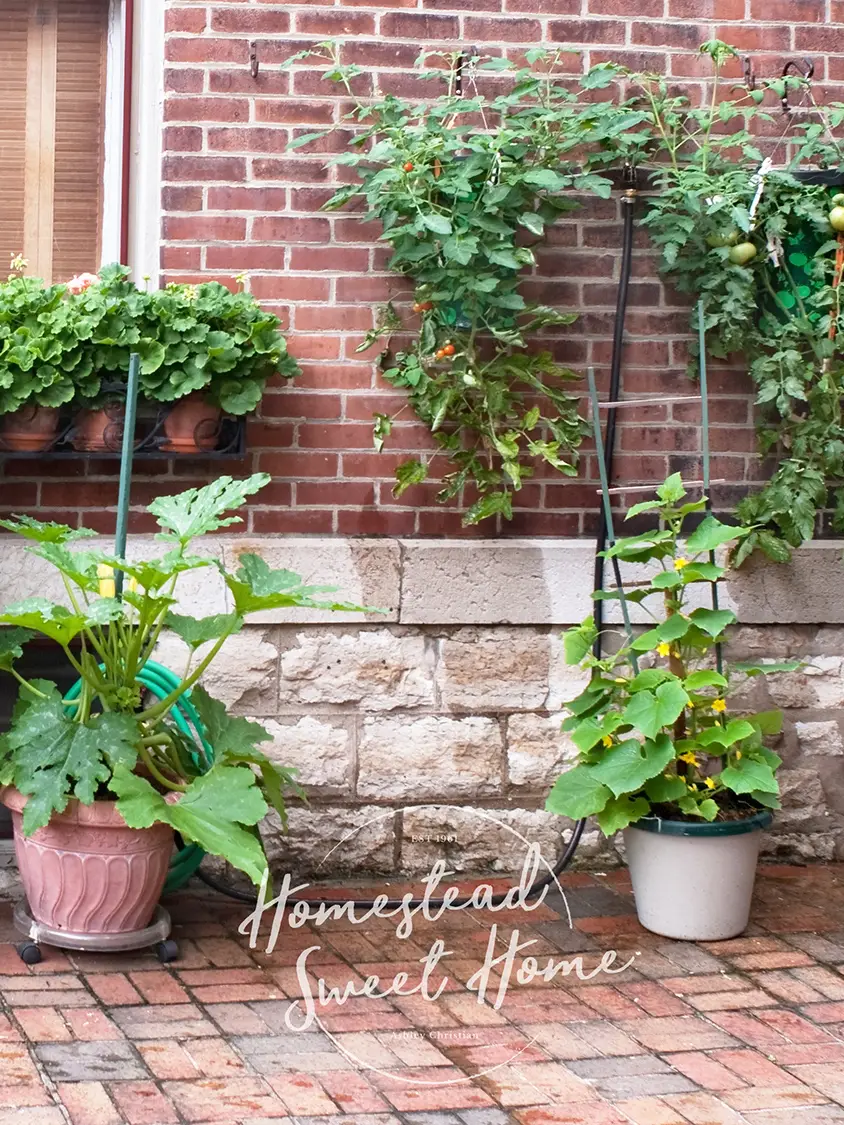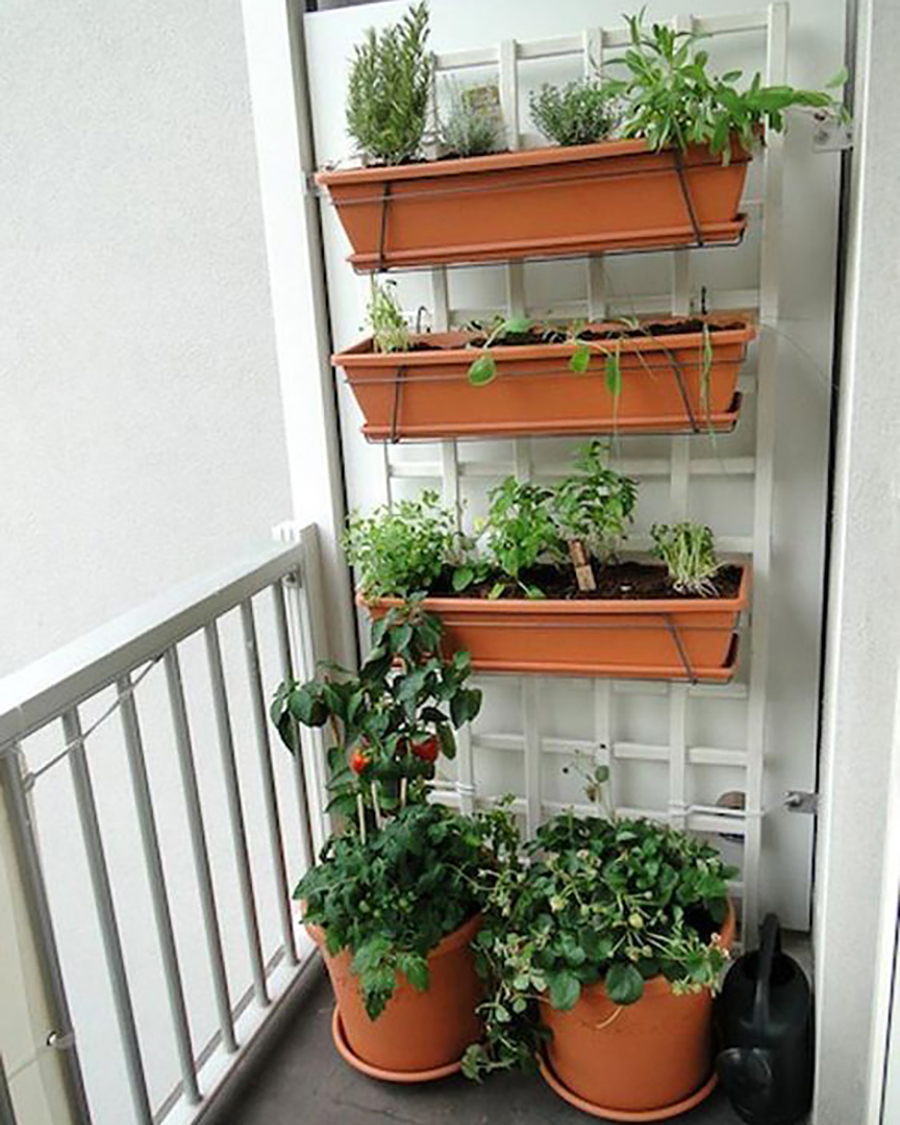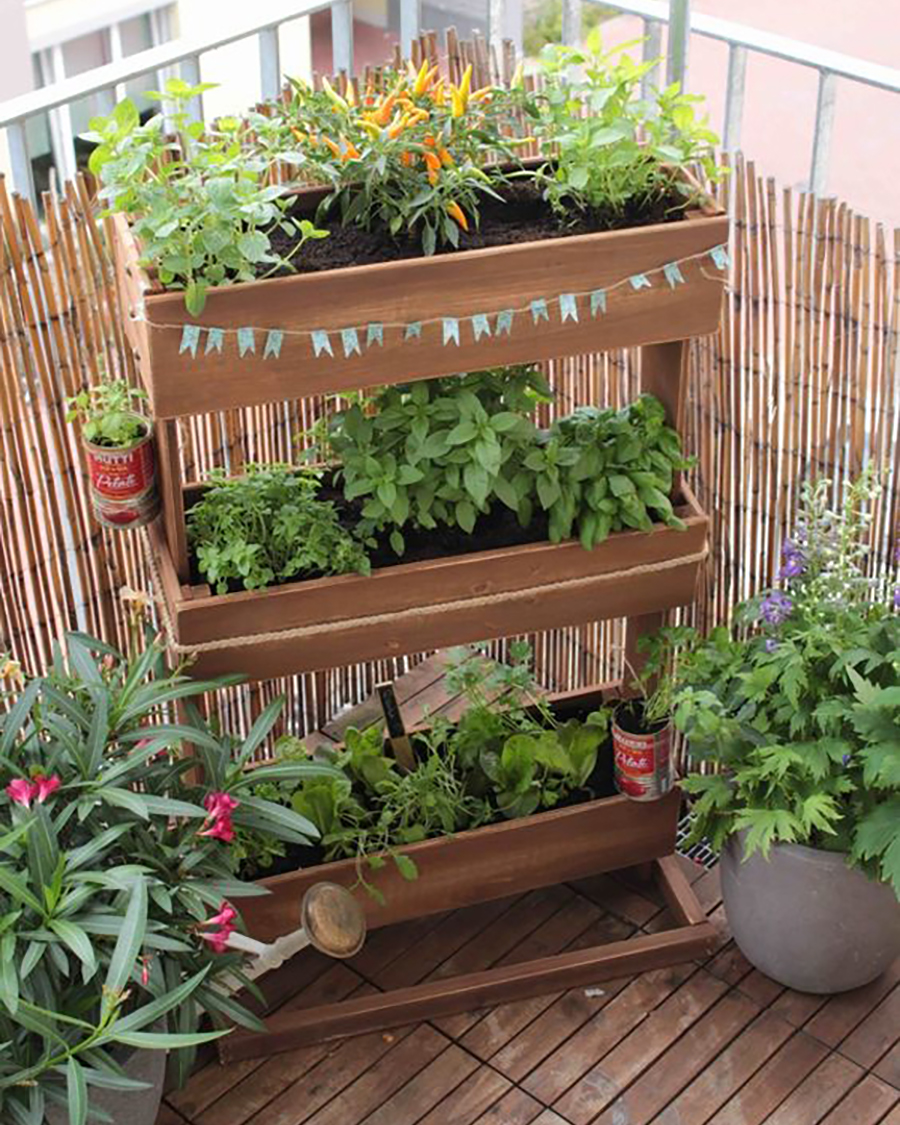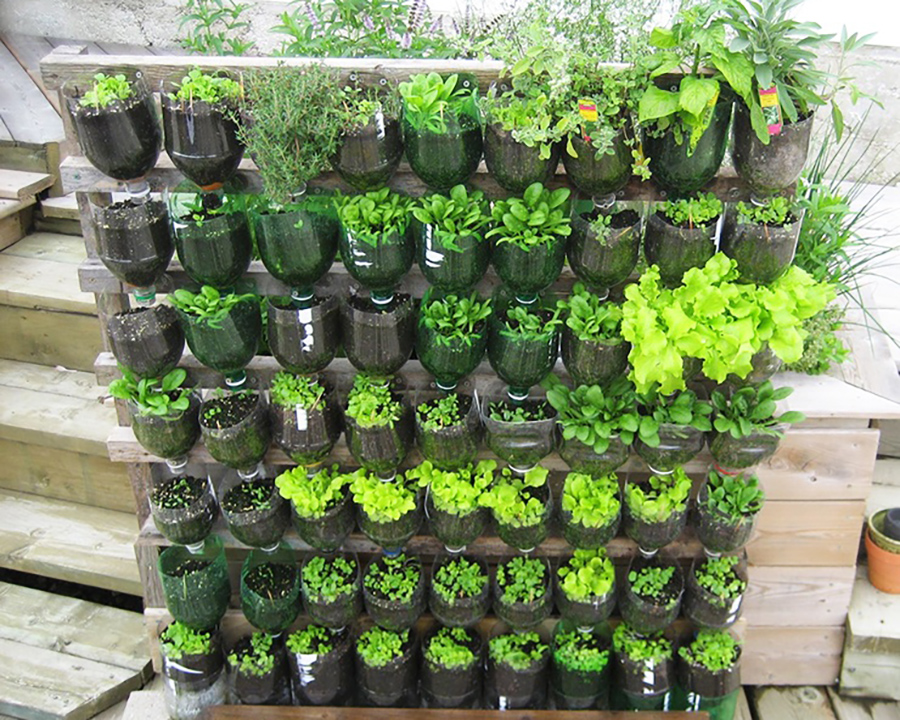Limited Gardening Space? Grow a Vertical Vegetable Garden for Your Balcony

Do you live in an apartment, have limited gardening space, or just want to make your balcony, porch, or deck edible and beautiful? With a few simple tips, anyone can grow a vertical garden for their balcony. If you have a covered balcony, you’ll need to refer to our list of shade-tolerant plants or steps for adding a daytime grow light on a timer. You’ll also need special watering instructions so you don’t rain on your neighbor below you. Get inspiration for vertical planters you can try to maximize your space.
Why Grow Vegetables in a Vertical Garden on Your Balcony?
If you live in a small space, knowing you couldn’t possibly grow enough vegetables to feed yourself, you may be wondering if it’s even worth it. Having been an apartment dweller for many years myself, the answer is a resounding yes, it’s worth it!
Studies have shown that the closer together people live, the levels of worry, stress, and sadness go up. We were designed to have room to breathe and regularly be out in nature. But for many of us, living on a farm instead of in a densely packed single-family neighborhood or apartment isn’t a possibility right now. And that’s okay. As the Bible wisely states, to everything there is a season. Growing a vertical garden for your balcony will help you find so much joy in this season of small living.
One of the wonderful benefits of gardening in a small area is the lowered cost and upkeep. When you live in a small area, you can be mindful of collecting less stuff, so you will have less and manage and clean, and more time to spend doing things that bring you joy with the people you love. Less stuff also means less debt and more resources for things that matter. Less sometimes really is more.
Another benefit of balcony gardening is that it’s good for the soul. It forces us to slow down and connect with God and nature. With the higher instances of stress, worry, fear, and sadness in crowded and urban areas, we need to be as intentional as possible to place ourselves in and around natural experiences that will refresh our souls. Garden, visit the farmer’s market, find some good hiking spots, walking paths, and local parks, and spend time in these places.
If you’ve been a human eating food these past few years you have seen the impact of supply chain shortages, weather disruptions, and toilet paper hoarding. Learning to grow your own food, even in small amounts in a vertical balcony garden, is an invaluable skill. Creating self-sufficiency no matter where we live gives us a feeling of safety and control in a chaotic world.
If you’ve ever shopped at a farmer’s market, you know how amazing organic farm-grown produce tastes compared to what you can buy in the supermarket. Many people don’t like vegetables because they simply haven’t tasted what they can grow themselves. Home-grown foods not only taste better, but they are exponentially better for you. Have I convinced you yet that you should go ahead with this project? I hope so!

You can even add a small greenhouse to your balcony garden! Inspo from Vietnamease balcony gardener Thuy Dao.
How to Get Enough Sunlight for Your Vertical Balcony Garden
The first step to planting an abundant vertical garden for your balcony is to make adjustments for sunlight. If your balcony is not covered, then you don’t need to do anything different when choosing and planting vegetables. But if your balcony is covered you’ll likely get limited direct or only indirect sunlight to your plants. There are three simple solutions to this problem:
First, choose vegetables that are shade tolerant and plant those. There are so many to choose from:
- Arugula
- Asparagus
- Beets
- Bok Choi
- Brocolli
- Brussel Sprouts
- Cabbage
- Carrots
- Cauliflower
- Celery
- Cilantro
- Garlic
- Horseradish
- Kale
- Leeks
- Lettuce
- Mustard Greens
- Parsnips
- Peas
- Potatoes
- Radish
- Rhubarb
- Rutabega
- Scallions
- Spinach
- Swiss Chard
The second solution is important if your sunlight is very limited. While some balconies get 3 to 6 hours of sun each day, many will get no direct sunlight, or have more limited light towards the house away from the edge of the balcony. If your space is shady, you’ll need a grow light or two. These grow lights will enable your plants to grow healthy and robust. You can also place these grow lights on a timer to simulate 8 to 12 hours of sunlight each day. A timer will save you the hassle of remembering to turn them off and on and will save you on your electric bill.
The third sunlight solution to consider is placing your sun-loving vegetables like tomatoes on the very edge of your balcony for maximum sunlight. You can even hang them over the edge in planter boxes so they can soak in all those wonderful rays.

Watering a Vertical Balcony Garden
Before you set up your vertical garden for your balcony, you need to decide how you are going to water it. If you have a water spigot nearby you can attach a hose and timer to, that’s something you’ll want to know ahead of time. If you don’t and you’ll need to use a watering can to carry water from inside to your balcony, you’ll want to know that too.
The beauty of creating a balcony garden in such small spaces and limited resources is the power of creativity. Some of the most incredible gardens have come from those with limited space but imagination in abundance. If you don’t have access to a hose or spigot, don’t despair. Consider the time you will spend outside watering your plants by hand as a blessing and a mental break in your day.
Plants need well-draining soil. If your balcony is on the ground level, this may not be an issue, but if you’re several stories up and at risk of “raining” on your neighbor, you’ll want to make sure your containers have holes in the bottom with trays underneath to catch the excess water.
Some people love the hydroponics method for a garden balcony, or even to use for gardening inside under grow lights. Hydroponics circulates nutrient-rich water through bare plants roots or through sand or gravel, so you don’t even need soil. Without the need for soil, plants can be packed much more closely together, allowing you to maximize your space.
You can purchase a hydroponics system or make one yourself, but if you don’t have access to a water spigot, this may not be a good choice for you.
Once you’ve planted your garden, either over or under watering can spell disaster for your plants or potentially a large water bill. Gardens do best when they are watered more deeply and less often. This is good news if you’re busy!
Your established plants need 1 inch of rain or water each week. Check your rainfall, and only supplement what is needed to equal 1 total inch of water each week. Use these tips to ensure your plants are getting the correct amount of water.
- New seeds and young plants with shallow roots will need to be watered more frequently until their root systems develop
- Use a rainfall app or inexpensive rain gauge to measure the amount of water your garden receives from nature each week
- For hand watering, use a long hose wand and soak the base of each plant for 30 to 60 seconds, or you can use a sprinkler or drip system
- 1 inch of water is equivalent to .62 gallons for every one square foot of garden space. Therefore if your garden is 4×8 with 32 square feet of space, you will need about 20 gallons of water for your garden
- To measure your water, simply go on observation when the soil seems saturated down to the root
- Don’t use water pressure so high it washes away dirt
- Use bark or hay mulch to protect from excess evaporation
Vertical Balcony Garden Soil
If you are gardening on your balcony, you won’t be planting directly in the ground, but in raised beds of some kind. You’ll need to purchase ingredients to make your soil. Your garden will only be as healthy as your soil.
There are many different recipes for the best soil to use in raised bed planting, and every gardener is partial to their own mix. In general, these recipes can be grouped like this:
- 60/30/10—60% topsoil, 30% compost, and 10% potting soil (this is actually a soilless blend of peat moss, vermiculite, and/or perlite.
- 50/50—50% topsoil and 50% compost
Luckily you can calculate how much soil you need for your particular sized beds with this handy calculator. If you need a whole lot of topsoil, it will probably be more economical to have it delivered by truckload rather than purchasing it in bags. Ask around and contact local landscaping companies that you know to be reputable, and find out who they use to deliver topsoil. You need to be cautious because what many companies refer to as topsoil, is actually fill-dirt that will make for a poor quality garden.
When buying your topsoil, you’ll need to do a little detective work to make sure what you’re getting will work for raised bed planting. Signs of high-quality topsoil are:
- Regionally sourced ingredients listed on the bag
- Nationally recognized compost certification on the bag
- Passes the squeeze test, sticks together when squeezed, but then falls apart again when you run your fingers through it
- Is not fill-dirt that some companies mistakenly call top-soil
Many gardeners like to amend their mix with additional organic compost materials like grass clippings, dead leaves, vermicompost (worm poop), or homemade compost. These things will help, but this step is optional as you will already have a great soil mix from your 60/30/10 or 50/50 mixes.

Vertical Balcony Garden Ideas
Small raised beds or fabric planters lining the balcony will be the simplest way for you to get started growing your own food, even in the city. You can also utilize hanging containers, and railing or window box containers to maximize your space. You may want to add a living wall or aquaponics towers along the sides of your balcony to make use of every square inch.
The benefit of most of these containers is they can move with you. So if you ever move to another apartment or even a home, your beloved garden can come too. To avoid leaving any holes if you are renting, use damage-free command hooks for your hanging baskets, and free-standing living walls or planting towers.
If you use hanging baskets, you can place them directly above raised planter beds to recycle water and keep your plants from raining on your downstairs neighbor. Here is a list of fruits and vegetables that grow exceptionally well in hanging baskets.
- Strawberries
- Cabbage
- Mustard Greens
- Chives
- Herbs
- Lettuce
- Cherry Tomatoes
- Cucamelons
- Eggplant
- Small Peppers
 Check out this living wall diy tutorial from Savannah Said It.
Check out this living wall diy tutorial from Savannah Said It.
What about you, have you ever grown anything on your balcony? What worked well for you? Share your experience in the comments below. Ready to get started with your vertical balcony garden? Check out our Complete Guide to Gardening at Home, Plus 5 Beginner Mistakes to Avoid.


Leave a Reply